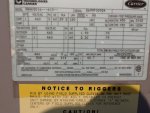electrofelon
Senior Member
- Location
- Cherry Valley NY, Seattle, WA
- Occupation
- Electrician
So If I am doing a service calculation for a building that has multiple Ac units, Am I correct that I just use the sum of all the "minimum circuit ampacity" on the nameplates, and do NOT need a continuous load or largest motor adder?
Thanks.
Thanks.

